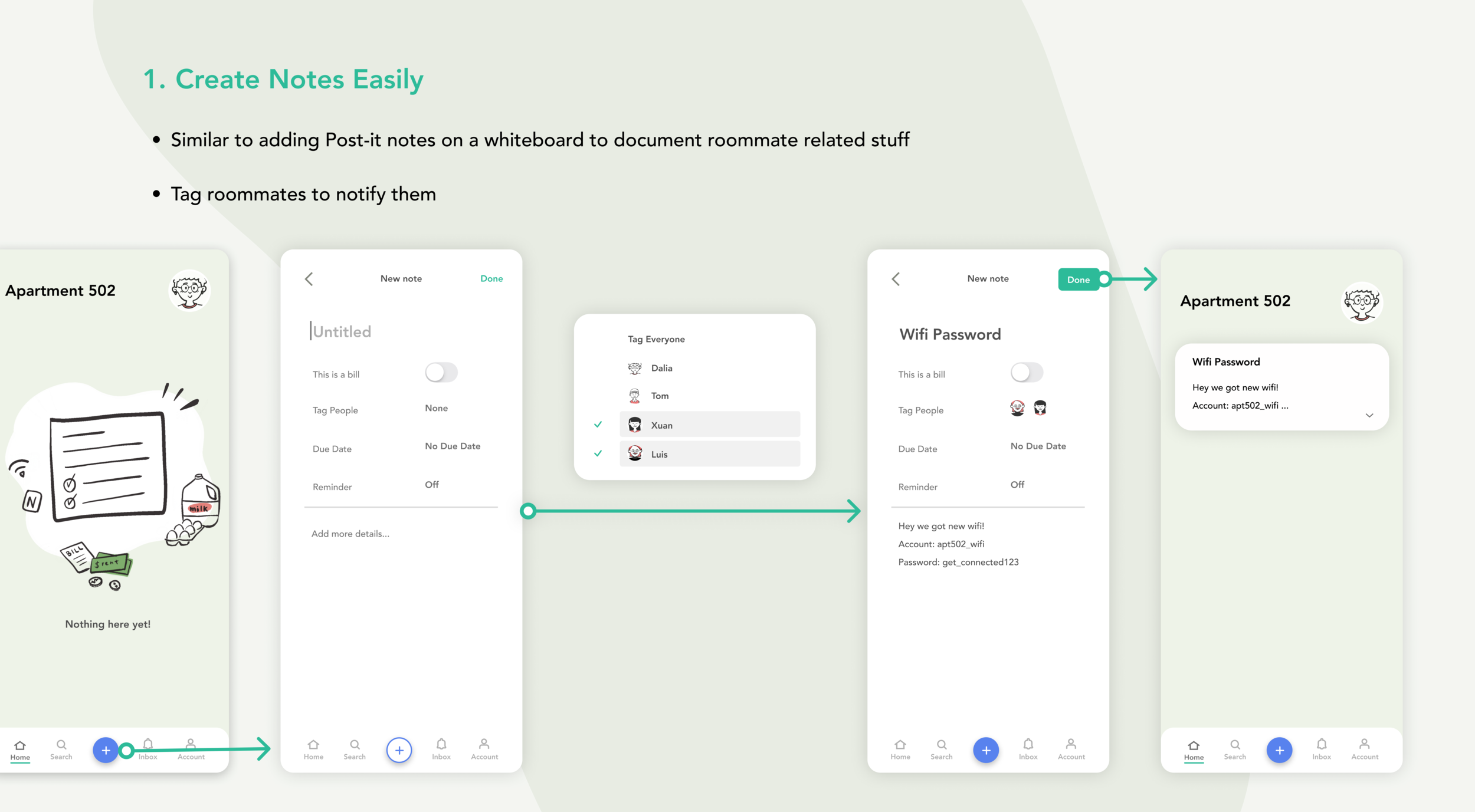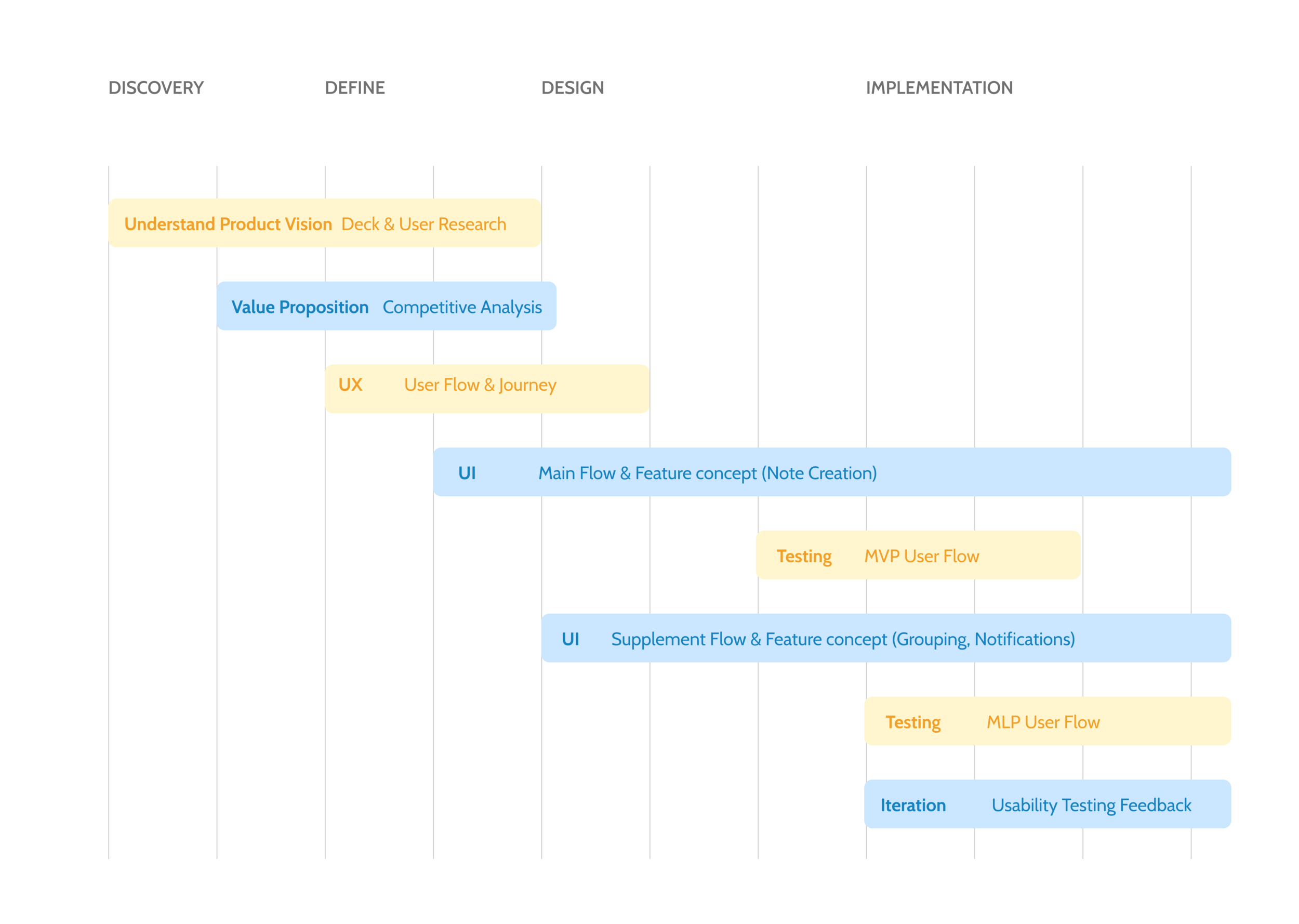WebApp Design
FridgeMate
#Concept #ProductDesign #MobileUX/UI
Overview
No more sticky notes on the fridge! We wanted to fix the problem of how roommate-related information is scattered through multiple apps and created FridgeMate to smooth the social interactions of the experience living together.
FridgeMate is a lightweight digital whiteboard that keeps track of roommate stuff for people living together. Focused on keeping it fun and easy to use, FridgeMate’s minimal design allows roommates to spend the least time possible to get in the know of things to do and settle up expenses.
Role
UX/UI Designer, Graphic Designer
Year
2020
Tools
Figma, Illustrator, Adobe After Effects
CONTEXT
FridgeMate is a passion project based in Seattle. We drew inspiration from the whiteboard we all have in our apartment (that is getting out of control). As roommates get involved in miscellaneous stuff, it can get difficult to keep all the information updated just in a message group. We aim to create a WebApp that takes care of the small pieces of information roommates deal with on a day-to-day basis.
THE CHALLENGE
Information for roommates is scattered across platforms, outdated and stressful.
People spend a lot of time jumping and scrolling between apps to find information
Using multiple apps makes it difficult for roommates to find and update the information they need such as credentials or expense history.
People get stressed over interactions
It’s always awkward asking someone about things they should have done. Maybe it slipped their mind or maybe they just haven’t had the time to do it yet. Either way, people want to avoid these confrontational moments especially with the roommates they live together with.
Main Users:
By conducting guerrilla research, we interview 6 people and identified the types of roommates who could be our target users.
OPPORTUNITY
How might we design the simplest app for people living together?
SOLUTION
We created FridgeMate, a digital whiteboard that keeps the small pieces of information organized for people living together.
Below are some highlights of the screens and features in our main user flow.







The Making of FridgeMate
Design Approach
Defining the Problem - Understanding our Audience
Empathizing for roommates
To better understand the pain points of living with roommates, I interviewed 6 young adults (age 23-28) in the Seattle area about their experience living with roommates.
We observed this repeated overwhelming fear of "face-to-face conversations” when it comes to reminding errands and settling expenses between roommates. About a third of the users do not know their roommate before they move in. Some common scenarios include assigned by school dorms or finding roommates online via Facebook groups. The unfamiliarity resulted in wanting to be extra respectful of each others’ boundaries and avoid conflicts. Therefore, we saw common anxiety across users bringing up sensitive subjects like money, especially when they have to bring it up a second or a third time.
POV 1 - Pam just moved to Seattle with two roommates she met online. She needs to document down the password for WiFi, the rent payment portal, and multiple streaming services. She created a note on FridgeMate because this saves time if they want to find the password next time. Messages get lost in a group chat and people can move in and out. Now they can find and update the password easily.
POV 2 - Kelly lives in a dorm with 3 other girls. The kitchen space is tight so they decided to share some groceries. Kelly and her roommates need to avoid buying the same item to save space. Kelly and her roommates use a checklist on FridgeMate because they can see what is needed on their phone wherever they are. Now they won’t buy duplicate items accidentally.
POV 3 - Meredith pays rent and utilities ahead for everyone every month. Her roommates each pays a different amount and it takes a lot of time setting up individual request on Venmo. Meredith needs an easy way to request and document all these expenses. Meredith set up repeat payment notes on FridgeMate because she wants to save time and effort. Now she doesn’t have to set up multiple requests every month.
POV 4 - Angela wants to keep the apartment clean so she split up bi-weekly chores with her roommates. Angela needs to know if her roommates have completed their chores without annoying them. Angela sets up a 3-day reminder because she wants to remain a friendly relationship with her roommates. Now the roommates get reminded by FridgeMate before the due date and Angela can know if her roommates have done the chores.
Defining the Problem - Understanding the Brand
Competitive Analysis
To get a practical understanding of competitors' product funnels comparing to our value props, I spent 40+ hours using competitors' apps and talked with 6 users about their experience using these apps.
Splitwise’s feature of splitting bills in various ways works well for complicated expenses but doesn’t really apply to the nature of the expenses between roommates such as rent, subscription, and utilities, which are usually a simpler amount, and sometimes repetitive.
On the other hand, the note-organizing apps are either too simple to collaborate such as Apple notes; Or on the other end of the spectrum where the apps are used in professional settings and the features are too complex for the usage of roommates.
The opportunity we saw here was something that tailors more towards the ideal experience of living with roommates, a note organizing app that is simple and collaborative and settles expenses in an easy way.
Interaction Design
User Flow Map
How does it work?
User Journey
Mapping out the user scenario to show what the user journey looks like:
Putting it all together
Design Iterations
We played around with different implementations based on new discoveries of user behaviors and feedback from usability testing before delivering the final high fidelity prototype.
Visual Design
Design System
For FridgeMate, the general vibe was to create a brand that was clean, easy to identify, and straight to the point. This resulted in a more muted color palette and bigger text sizes. The design system drew inspiration from the note organizing apps but also infused elements from social interactions in apps like Instagram and Venmo.
The design system includes colors, type, rules on spacing & grids, as well as important components.
Lessons Learned
Don’t “Create“ needs.
As we boiled down that FridgeMate is essentially a task organization app, the fact that there are already so many amazing task organization apps out there throws this question in our face — what makes us different?
Immediately our mind goes to the easiest answer — We have to be better than others.
However, who am I to come up with groundbreaking designs that are going to change how people organize tasks? Furthermore, after interviewing a few users, the common frustration they have with apps is actually how complicated they are to use. For example, different from a company, there is little to no chance that roommates would need to invite people to join aboard all the time so we don’t have to put “invite members“ on every task. Also, this is not a messaging app and not intended to replace one, so we had to remind ourselves to stop piling up features and focus on essential designs that spark joy.
Creating imaginary needs confuses the users and slows down the development process. I learned how valuable it is to get the MVP done first and get feedback to evaluate if our solution really satisfies the target users.
What makes us different? — We just have to be better than the other apps for people living together.










